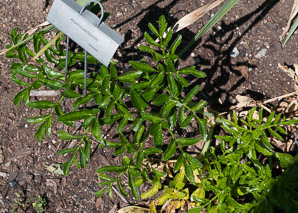
|
Angelica pachycarpa Lange. Angelica
Angelica is a native of Spain and western Portugal, now naturalized in New Zealand, and not found in the wild in North America. Identification: Plants form neat mounds about 3′ (91 cm) around. Sometimes described as a biennial or as a "short-lived perennial," other sources describe it as perennial. Leaves are jade green and glossy, closely connected to their stems. Flowers are large, tight umbels 4-8″ (10-20 cm) across. Fruits up to ⅜″ (1.2 cm) long are brown with lighter colored wings. Online References:
The Fine Gardening Plant Guide
Angelica pachycarpa description by Thomas H. Kent, last updated 25 May 2020. © FloraFinder.org. All rights reserved. |
9/7/2010 · Tower Hill Botanic Garden, Boylston, Massachusetts · ≈ 15 × 10″ (39 × 26 cm) Range: Zones 8a-11:
|



